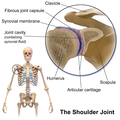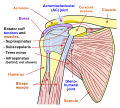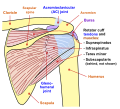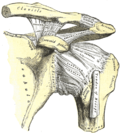Shoulder joint
Shoulder joint
The shoulder joint is a major joint in the human body. It is a ball and socket joint that connects the upper arm bone, known as the humerus, to the shoulder blade, or scapula. The shoulder joint is one of the most mobile joints in the body, allowing for a wide range of motion in the arm.
Anatomy[edit]
The shoulder joint is made up of three bones: the humerus, the scapula, and the clavicle. The head of the humerus fits into a shallow socket in the scapula. This socket is called the glenoid. The acromion and coracoid process are parts of the scapula that connect with the clavicle to form the shoulder girdle.
Function[edit]
The shoulder joint allows for a wide range of motion. This includes flexion, extension, abduction, adduction, internal rotation, and external rotation. The shoulder joint also allows for circumduction, which is a combination of these movements.
Clinical significance[edit]
Injuries and conditions that can affect the shoulder joint include rotator cuff tear, shoulder impingement syndrome, shoulder dislocation, frozen shoulder, and arthritis. Treatment for these conditions can include physical therapy, medication, and in some cases, surgery.
See also[edit]
|
|
|
Shoulder_joint[edit]
-
Blausen 0797 ShoulderJoint
-
Subacromial space on outlet view X-ray
-
Bursae shoulder joint normal
-
Shoulder motion with rotator cuff (supraspinatus)
-
Shoulder muscle - force couple of rotator cuff
-
Shoulder joint
-
Shoulder joint back-en
-
Gray326
-
Slide1KKKK
-
Slide7KKKK
Ad. Transform your life with W8MD's Budget GLP-1 injections from $75


W8MD offers a medical weight loss program to lose weight in Philadelphia. Our physician-supervised medical weight loss provides:
- Weight loss injections in NYC (generic and brand names):
- Zepbound / Mounjaro, Wegovy / Ozempic, Saxenda
- Most insurances accepted or discounted self-pay rates. We will obtain insurance prior authorizations if needed.
- Generic GLP1 weight loss injections from $75 for the starting dose.
- Also offer prescription weight loss medications including Phentermine, Qsymia, Diethylpropion, Contrave etc.
NYC weight loss doctor appointmentsNYC weight loss doctor appointments
Start your NYC weight loss journey today at our NYC medical weight loss and Philadelphia medical weight loss clinics.
- Call 718-946-5500 to lose weight in NYC or for medical weight loss in Philadelphia 215-676-2334.
- Tags:NYC medical weight loss, Philadelphia lose weight Zepbound NYC, Budget GLP1 weight loss injections, Wegovy Philadelphia, Wegovy NYC, Philadelphia medical weight loss, Brookly weight loss and Wegovy NYC
|
WikiMD's Wellness Encyclopedia |
| Let Food Be Thy Medicine Medicine Thy Food - Hippocrates |
Medical Disclaimer: WikiMD is not a substitute for professional medical advice. The information on WikiMD is provided as an information resource only, may be incorrect, outdated or misleading, and is not to be used or relied on for any diagnostic or treatment purposes. Please consult your health care provider before making any healthcare decisions or for guidance about a specific medical condition. WikiMD expressly disclaims responsibility, and shall have no liability, for any damages, loss, injury, or liability whatsoever suffered as a result of your reliance on the information contained in this site. By visiting this site you agree to the foregoing terms and conditions, which may from time to time be changed or supplemented by WikiMD. If you do not agree to the foregoing terms and conditions, you should not enter or use this site. See full disclaimer.
Credits:Most images are courtesy of Wikimedia commons, and templates, categories Wikipedia, licensed under CC BY SA or similar.
Translate this page: - East Asian
中文,
日本,
한국어,
South Asian
हिन्दी,
தமிழ்,
తెలుగు,
Urdu,
ಕನ್ನಡ,
Southeast Asian
Indonesian,
Vietnamese,
Thai,
မြန်မာဘာသာ,
বাংলা
European
español,
Deutsch,
français,
Greek,
português do Brasil,
polski,
română,
русский,
Nederlands,
norsk,
svenska,
suomi,
Italian
Middle Eastern & African
عربى,
Turkish,
Persian,
Hebrew,
Afrikaans,
isiZulu,
Kiswahili,
Other
Bulgarian,
Hungarian,
Czech,
Swedish,
മലയാളം,
मराठी,
ਪੰਜਾਬੀ,
ગુજરાતી,
Portuguese,
Ukrainian












